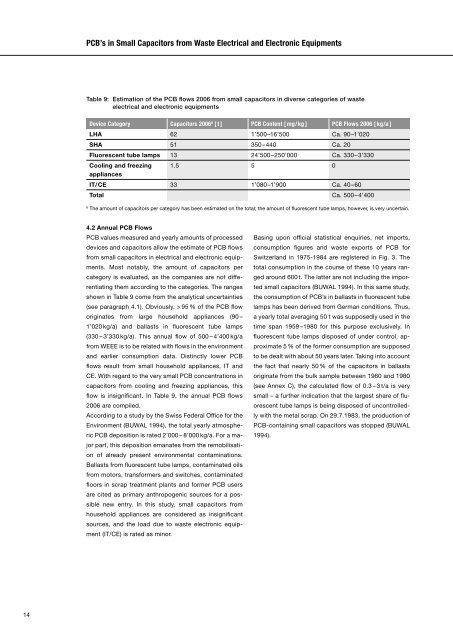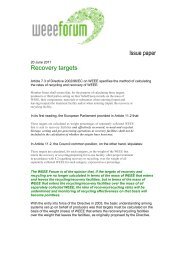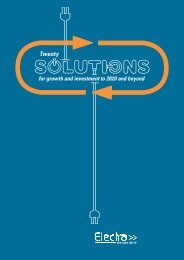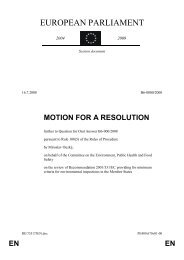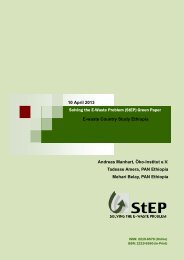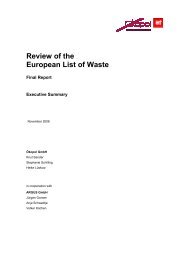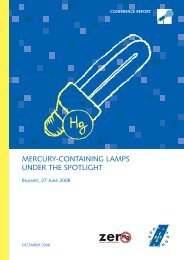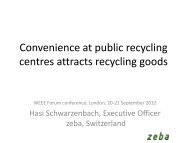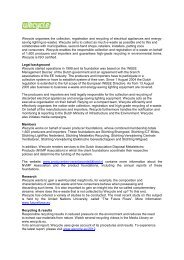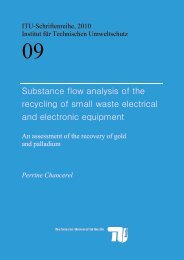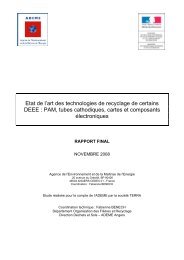by SENS and SWICO - Ecotic
by SENS and SWICO - Ecotic
by SENS and SWICO - Ecotic
You also want an ePaper? Increase the reach of your titles
YUMPU automatically turns print PDFs into web optimized ePapers that Google loves.
PCB’s in Small Capacitors from Waste Electrical <strong>and</strong> Electronic EquipmentsTable 9: Estimation of the PCB fl ows 2006 from small capacitors in diverse categories of wasteelectrical <strong>and</strong> electronic equipmentsDevice Category Capacitors 2006 8 [ t ] PCB Content [ mg/kg ] PCB Flows 2006 [ kg/a ]LHA 62 1’500–16’500 Ca. 90–1’020SHA 51 350–440 Ca. 20Fluorescent tube lamps 13 24’500–250’000 Ca. 330–3’330Cooling <strong>and</strong> freezingappliances1.5 5 0IT/CE 33 1’080–1’900 Ca. 40–60Total Ca. 500–4’4008The amount of capacitors per category has been estimated on the total; the amount of fl uorescent tube lamps, however, is very uncertain.4.2 Annual PCB FlowsPCB values measured <strong>and</strong> yearly amounts of processeddevices <strong>and</strong> capacitors allow the estimate of PCB fl owsfrom small capacitors in electrical <strong>and</strong> electronic equipments.Most notably, the amount of capacitors percategory is evaluated, as the companies are not differentiatingthem according to the categories. The rangesshown in Table 9 come from the analytical uncertainties(see paragraph 4.1). Obviously, > 95 % of the PCB fl oworiginates from large household appliances (90 –1’020 kg/a) <strong>and</strong> ballasts in fl uorescent tube lamps(330 – 3’330 kg/a). This annual fl ow of 500 – 4’400 kg/afrom WEEE is to be related with fl ows in the environment<strong>and</strong> earlier consumption data. Distinctly lower PCBfl o ws result from small household appliances, IT <strong>and</strong>CE. With regard to the very small PCB concentrations incapacitors from cooling <strong>and</strong> freezing appliances, thisfl o w is insignifi cant. In Table 9, the annual PCB fl ows2006 are compiled.According to a study <strong>by</strong> the Swiss Federal Offi c e for theEnvironment (BUWAL 1994), the total yearly atmosphericPCB deposition is rated 2’000 – 8’000 kg/a. For a majorpart, this deposition emanates from the remobilisationof already present environmental contaminations.Ballasts from fl uorescent tube lamps, contaminated oilsfrom motors, transformers <strong>and</strong> switches, contaminatedfl o ors in scrap treatment plants <strong>and</strong> former PCB usersare cited as primary anthropogenic sources for a possiblenew entry. In this study, small capacitors fromhousehold appliances are considered as insignifi cantsources, <strong>and</strong> the load due to waste electronic equipment(IT/CE) is rated as minor.Basing upon offi c ial statistical enquiries, net imports,consumption fi gures <strong>and</strong> waste exports of PCB forSwitzerl<strong>and</strong> in 1975-1984 are registered in Fig. 3. Thetotal consumption in the course of these 10 years rangedaround 600 t. The latter are not including the importedsmall capacitors (BUWAL 1994). In this same study,the consumption of PCB’s in ballasts in fl uorescent tubelamps has been derived from German conditions. Thus,a yearly total averaging 50 t was supposedly used in thetime span 1959 –1980 for this purpose exclusively. Infl u orescent tube lamps disposed of under control, approximate5 % of the former consumption are supposedto be dealt with about 50 years later. Taking into accountthe fact that nearly 50 % of the capacitors in ballastsoriginate from the bulk sample between 1960 <strong>and</strong> 1980(see Annex C), the calculated fl ow of 0.3 – 3 t/a is verysmall – a further indication that the largest share of fl u-orescent tube lamps is being disposed of uncontrolledlywith the metal scrap. On 29.7.1983, the production ofPCB-containing small capacitors was stopped (BUWAL1994).14


